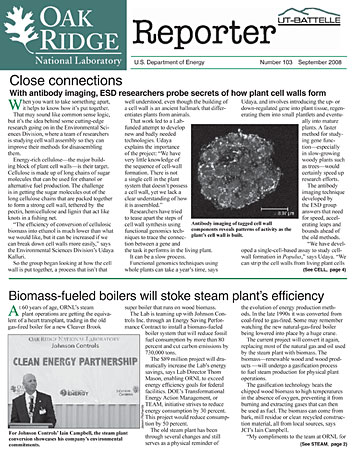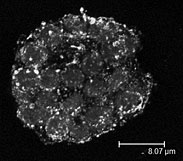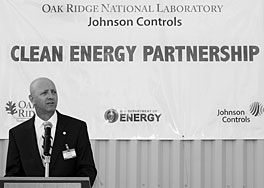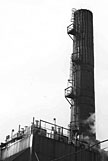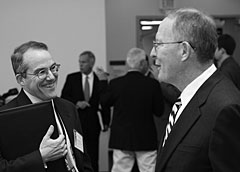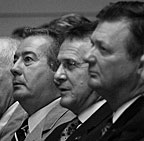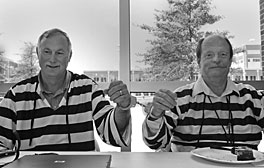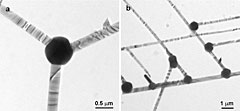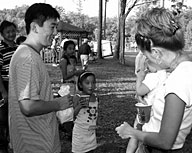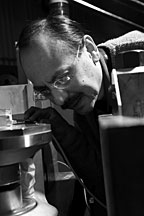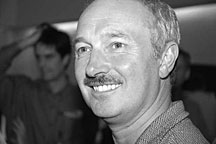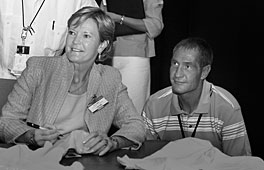 |
Number 103, September 2008 |
 Close connections
Close connections
With antibody imaging, ESD researchers probe secrets of how plant cell walls form
|
|
Antibody imaging of tagged cell wall components reveals patterns of activity as the plant’s cell wall is built. |
When you want to take something apart, it helps to know how it’s put together.
That may sound like common sense logic, but it’s the idea behind some cutting-edge research going on in the Environmental Sciences Division, where a team of researchers is studying cell wall assembly so they can improve their methods for disassembling them.
Energy-rich cellulose—the major building block of plant cell walls—is their target. Cellulose is made up of long chains of sugar molecules that can be used for ethanol or alternative fuel production. The challenge is in getting the sugar molecules out of the long cellulose chains that are packed together to form a strong cell wall, tethered by the pectin, hemicellulose and lignin that act like knots in a fishing net.
“The efficiency of conversion of cellulosic biomass into ethanol is much lower than what we would like, but it can be increased if we can break down cell walls more easily,” says the Environmental Sciences Division’s Udaya Kalluri.
So the group began looking at how the cell wall is put together, a process that isn’t that well understood, even though the building of a cell wall is an ancient hallmark that differentiates plants from animals.
That work led to a Lab-funded attempt to develop new and badly needed technologies. Udaya explains the importance of the project: “We have very little knowledge of the sequence of cell-wall formation. There is not a single cell in the plant system that doesn’t possess a cell wall, yet we lack a clear understanding of how it is assembled.”
Researchers have tried to tease apart the steps of cell wall synthesis using functional genomics techniques to trace the connection between a gene and the task it performs in the living plant.
It can be a slow process.
Functional genomics techniques using whole plants can take a year’s time, says Udaya, and involves introducing the up- or down-regulated gene into plant tissue, regenerating them into small plantlets and eventually into mature plants. A faster method for studying gene function—especially in slow-growing woody plants such as trees—would certainly speed up research efforts.
The antibody imaging technique developed by the ESD group answers that need for speed, accelerating leaps and bounds ahead of the old methods.
“We have developed a single-cell-based assay to study cell-wall formation in Populus,” says Udaya. “We can strip the cell walls from living plant cells and then use antibodies to color-code different cell wall components and watch what happens as the cells regenerate their cell walls in real time.”
|
Kalluri |
This antibody labeling assay can be carried out in a matter of days, a much faster turnaround compared with the time it takes to regenerate a Populus tree from transformed plant material.
Speed is not the only advantage: It may also give a more realistic view of cell wall assembly.
Previous methods for visualizing cell wall development often required the plant materials to be fixed by treating them with chemicals or freezing temperatures, then fracturing or slicing the samples before observing them under a high-powered microscope. Udaya says their technique is much more representative of what is happening in native cell walls because it uses living cells and doesn’t require fixatives that might alter the structure or appearance of cell wall components.
But they had to jump several hurdles to develop the method, altering existing protocols for isolating live cells and adapting them for their experimental system, the cottonwood (Populus) tree.
Once the cells were successfully isolated, the researchers had to figure out how to keep them alive, incubating them in a mixture of hormones and nutrients that mimic the normal cellular
environment.
The cells lit up. Their idea really was going to work. |
“After we removed their cell walls, we weren’t even sure if we could keep them alive long enough for the walls to be regenerated,” says Udaya.
After successfully isolating the naked Populus cells and keeping them alive, they knew they were close to the true test of their
technique.
“The first experiment we did was to throw in several different antibodies all at once to increase our chances of getting a positive signal,” says Udaya. The cells lit up, giving the group visible affirmation that their idea really was going to work.
Since that first experiment, the group has not slowed down. Says Udaya, “We have about 150 different antibodies available now, and we’re scaling up the process.”
They want to look at cells during all stages of cell wall growth and identify the roles of the different components involved in the complex process of building and reinforcing the cell wall.
“We are excited to have early, concrete results. Now we can alter a gene or change the culture conditions and see the effects on cell wall construction in a matter of days rather than years” says Udaya. “Using this technique we finally have another tool to help put together a better picture of how plant cell walls are formed.”
Revolutionary advances like this lie at the heart of the BioEnergy Science Center’s mission to develop sustainable and economical methods for biofuel production.
“Our understanding of the cell wall—which could be one of the largest sources of renewable biomass if only we can fully access it—has to increase for us to accomplish the goal of replacing imported petroleum with renewable biofuels. That’s why this project is so important and why we’re really happy that it succeeded so well,” says Udaya. —Sarah Wright ![]()
 Biomass-fueled boilers will stoke steam plant’s efficiency
Biomass-fueled boilers will stoke steam plant’s efficiency
At 60 years of age, ORNL's steam plant operations are getting the equivalent of a heart transplant, trading in the old gas-fired boiler for a new boiler that runs on biomass.
|
For Johnson Controls’ Iain Campbell, the steam plant conversion showcases his company’s environmental commitments. |
The Lab is teaming up with Johnson Controls Inc. through an Energy Saving Performance Contract to install a biomass-fueled boiler system that, combined with a natural gas-fired superboiler to be located in Melton Valley, will reduce fossil fuel consumption by more than 80 percent and cut carbon emissions by 730,000 tons.
The $89 million project will dramatically increase the Lab’s energy savings, says Lab Director Thom Mason, enabling ORNL to exceed energy efficiency goals for federal facilities. DOE’s Transformational Energy Action Management, or TEAM, initiative strives to reduce energy consumption by 30 percent. This project would reduce consumption by 50 percent.
The old steam plant has been through several changes and still serves as a physical reminder of the evolution of energy production methods. In the late 1990s it was converted from coal-fired to gas-fired. Some may remember watching the new natural-gas-fired boiler being lowered into place by a huge crane.
The current project will convert it again, replacing most of the natural gas and oil used by the steam plant with biomass. The biomass—renewable wood and wood products —will undergo a gasification process to fuel steam production for physical plant operations.
The gasification technology heats the chipped wood biomass to high temperatures in the absence of oxygen, preventing it from burning and extracting gases that can then be used as fuel. The biomass can come from bark, mill residue or clean recycled construction material, all from local sources, says JCI’s Iain Campbell.
“My compliments to the team at ORNL for addressing these energy and environmental issues. You are charting the course for others to follow,” said Campbell at the August 11 announcement.
As for JCI’s contributions, Iain says that they support the triple bottom line: “We are committed to economic prosperity, social responsibility and environmental stewardship, and this project showcases all of those commitments.”
|
News of the ORNL Steam Plant’s conversion to a state-of-the-art biomass-fueld boiler comes in the facility’s 60th year of service. It came on-line in 1948. |
“A lot of people have put their time, talent, and effort into this project,” says JCI project manager Dave Peters. The payoff in energy savings should be massive. The emissions reduction will be equivalent to removing 250,000 cars from the road, says Dave. The water saved will be enough for half a year of showers or 170 million gallons per year and the wood used as biomass will amount to 750 pounds of waste wood that would have ended up in landfills, he says.
The project will also get rid of the old steam lines running between the East and West ends of the Lab’s campus, says Greg Palko of the Lab’s Energy Management group.
The old pipes are big energy-wasting offenders. First, a lot of heat is lost as the steam travels from one side of the campus to the other, but they also waste a huge amount of energy because the steam has to be at a higher pressure—which means higher temperature—to pipe it such distances.
By removing the pipe and installing a boiler on the east end of campus, they can reduce the pressure, and therefore the temperature, of the steam by more than half, says Greg.
ORNL has one of the oldest physical plants in the DOE laboratory system, but with the conversion to biomass, it will utilize some of the newest technology.—Sarah Wright
Sarah Wright is this summer’s intern from the University of Tennessee’s science writing program. ![]()
 S&T conference panel focuses on
large facilities’ role in big science
S&T conference panel focuses on
large facilities’ role in big science
Large facilities have become our biggest
research tools, playing an increasingly important role in determining the ability of the United States to compete in science and technology, says Pat Gallagher, director of the National Institute of Science and Technology’s Center for Neutron Research.
|
ORNL Deputy Director for Science & Technology Jim Roberto, who organized the National Science & Technology Summit, talks with Sen. Lamar Alexander, who championed the America COMPETES Act in Congress. |
Assembled at ORNL for the National Science and Technology Summit, panelists discussed the opportunities and challenges presented by large multimillion-dollar facilities like the Spallation Neutron Source. DOE Deputy Director for Science Programs Pat Dehmer said large projects require collaboration throughout the lifetime of the facility, a process which remains largely unchartered territory.
“The people who take on these projects are pioneers; they keep the U.S. on the forefront of scientific research,” Dehmer said.
The SNS, built through the collaborative efforts of six national laboratories, illustrates the increasingly common phenomena of pan-agency cooperation to build large facilities, which will become pan-nation as facilities get bigger and more expensive, says Gallagher.
“We need to figure out how as a country we approach international projects, but the payoff is great,” said the California Institute of Technology’s Linde Professor of Physics, Barry Barish. The goal is to develop, recruit and retain the brightest minds, and large facilities are required to stay competitive.
“Virtually every discipline is dominated by large facilities—it justifies the investment,” said Gallagher.
The panelists kept returning to one important issue: maintaining stable, predictable funding for the construction—which can take decades – and the operation—which will last even longer with upgrades and expansion over time—of these large collaborative facilities. Cornell University’s Maury Tigner summed it up: “If you can’t plan, you cannot compete.”
Director of the National Science Foundation, Arden Bemet, and Ambassador Richard Russell, associate director and deputy director for technology for the White House Office of Science and Technology, gave opening remarks, emphasizing the importance of science and technology for the United States’ continuing ability to compete in the global scientific community.
Summit attendees included representatives from the nation’s top universities and industries. Panel topics included investment and resource allocation in science and technology and STEM education from kindergarten through graduate school.
The goal of the two-day summit was to develop recommendations and action steps that address future challenges to the United States’ science, technology, engineering and mathematics enterprises, which will be presented to Congress as part of the America COMPETES Act.—Sarah Wright ![]()
 |
 Value of a good education
Value of a good education
Former Lab Director Bill Madia says it all started with someone’s off-the-cuff remark: “We need to build a new high school.” That observation, in the early days of UT-Battelle’s tenure at ORNL, culminated August 18 in the dedication of the renovated Oak Ridge High School.
|
Two former ORNL Directors, Bill Madia (left) and Jeff Wadsworth (right), came to Oak Ridge for the high school dedication. UT President John Petersen is in the center. |
ORHS, built in the 1950s, was looking a little tatty as it approached its golden anniversary. Recognizing the importance of good schools to recruiting top talent to the Lab, UT-Battelle kicked off the renovation effort by funding a feasibility study that identified needs and options. Next came the sticker shock—estimates topped $60 million—and the community’s response, which was to vote overwhelmingly to fund the project with the state’s only successful tax referendum of that year.
Private sources, including the DOE contractors, provided $8 million through the Oak Ridge Public Education Foundation, the largest amount in the state’s history for a K-12 school.
Teachers at the open house appeared thrilled with the new facilities and resources, including physics teacher Peggy Bertrand, whose classroom looks more like a lab, complete with an overhead track for suspending teaching items. “We were in here last year, but now I’ve learned how to hang things on this track, so we’re going to have physics flying everywhere,” she says.
The key outcome for ORNL is that, when prospective employees check out the community and weigh their options, Oak Ridge High School will definitely be in the plus column.
The dedication was enough to draw an ex-pat Oak Ridger all the way across the country. “I wouldn’t miss this,” said Madia, now director of operations at Stanford Linear Accelerator Center in Palo Alto, Calif., as he stood in the newly refurbished auditorium.
 Ex-CIA head: Security, energy linked
Ex-CIA head: Security, energy linked
Using the ghosts of John Muir and General Patton to represent different viewpoints on the nation’s energy problems, former CIA Director James Woolsey argues that although the two men might have very different attitudes toward the problem, they could still agree on many of the solutions.
Part of the Lab’s distinguished lecture series, Woolsey’s August 21 talk, titled “Energy, Security, and the Long War of the 21st Century,” described the potential transformations required for innovations in energy. He emphasized energy’s role in homeland defense and the importance of making our society and economy more resilient in the face of the “long war” against terrorists and their
supporters.
“The amount of energy we produce and the way we produce it—over 50 percent from coal—has the potential to create malignant problems,” said Woolsey, referring to the dangers concomitant with climate change.
While the threat of climate change is real, nature does not have an agenda like terrorists do, says Woolsey. He points out that while the country is vulnerable to both physical attack and cyber attack to the electricity grid, the real risk to national security is our oil dependence.
Oil dependence is funding terrorism. “Turn the rear view mirror a little to the left” the next time you get gas. “You will see the person who is paying for those eight-year-old boys to be trained as suicide bombers,” he says.
Reasons for calling for new energy sources may differ, like Muir and Patton’s certainly would, but the solutions are surprisingly similar, says Woolsey. Breaking oil’s monopoly is important to those concerned with carbon footprints and national security alike.
Woolsey, now a senior advisor for a tech consulting firm, challenged the overflow crowd to, “invent and innovate our way out of this box as fast as possible,” garnering a burst of applause from the audience of researchers.
 ‘Eugene’ is on the computing scene
‘Eugene’ is on the computing scene
|
|---|
Wigner |
The late Nobel laureate and ORNL’s first scientific director, Eugene Wigner, probably never dreamed he’d have a supercomputer named after him, but here it is. The Center for Computational Sciences’ latest IBM Blue Gene/P System has been dubbed “Eugene” in his honor.
Wigner, who was an incredibly fast thinker and one of the driving minds behind the Manhattan Project and the field of nuclear engineering, saw only the early days of high-performance computing.
What he did see, he liked. He once told an ORNL researcher, “I think computers are a good thing.”
His namesake, Eugene, is a 27-teraflop system with approximately 45 million processor hours available for user projects, ORNL staff members and university partner members, says the NCCS’s Jim Hack.
There is no telling what Wigner himself might have accomplished with such a resource.
Reported by Sarah Wright and Bill Cabage |
|
These two “perps” were doing time for a good cause on August 21. ESH&Q Director Joe Herndon (right) and the Neutron Sciences Directorate’s Frank Kornegay were placed under house arrest by ORNL Laboratory Protection and the UT-Battelle Memory Walk Team. Their pleas for release were not in vain; they collected nearly $4200 in pledges from co-workers toward the East Tennessee Alzheimer’s Association campaign. |
 ORNL People
ORNL People
|
|---|
Miller |
The Materials Science & Technology Division’s Mike Miller will be inducted as a TMS (The Minerals, Metals and Materials Society) fellow in recognition of his “world-renowned leadership in the development and utilization of atom probe tomography for characterization of materials.” Mike has published over 400 peer-reviewed publications and has been very active in professional societies during his career. He will be one of only 100 TMS fellows, a select group that includes former Lab Director Jeff Wadsworth and six others with ORNL connections.
Corporate Fellow John T. Mihalczo received the Institute of Nuclear Materials Management Distinguished Service Award for long-term contributions to the nuclear materials management profession during his 50-year tenure at the Lab. He was praised for his invention and development of many technologies, as well as his outstanding reputation as a student mentor. At the same meeting, Nuclear Science & Technology intern Nathan Rowe placed second in the student paper competition, winning a $500 scholarship for his talk, “Distributed Radiation Monitoring Via a Secure Wireless Sensor Platform.”
|
|---|
Bogard |
The Biosciences Division’s Jim Bogard has been honored as a fellow of the Health Physics Society. Jim has served the society on committees and as president and secretary of the East Tennessee Chapter. He has also served as president of the American Academy of Health Physics, as chairman of two HPS Standards Committee/American National Standards Institute writing groups, as a member of a National Council on Radiation Protection and Measurements task group and as a contributor to the Health Physics Society’s “Ask the Experts” Web feature.
The Environmental Sciences Division’s Udaya Kalluri received the Knoxville YWCA Tribute to Women award in the science and technology category. Udaya is a researcher in ESD’s Plant Systems Biology group (see story, page 1). She was nominated by colleague Stan Wullschleger. Anjali Bisaria, Energy & Transportation Science Division, won the outstanding youth category. Mike Schultze and Duminda Randeniya are her mentors in the Decision Engineering group. Other ORNL finalists included Linda Duncan and Teresa Kay Williams (administrative/clerical professional) and Neena Imam and Janet L. Hopson (science and technology).
|
|---|
Pin |
The Environmental Sciences Division’s Russell Lee has been appointed to the National Academies Committee on Health, Environmental and Other External Costs and Benefits of Energy Production and Consumption. The committee will be evaluating the external costs and benefits associated with the production, distribution, and consumption of energy that are not fully reflected in the prices paid for it.
Robotics & Energetic Systems Group Leader François Pin was on the U.S. Soaring Team that competed in the 30th FAI World Glider Championships in Rieti, Italy. An experienced glider pilot with more than 3000 hours logged, François has flown in 16 U.S. nationals and has been a member of the U.S. team four times.
 Come and see
Come and see
HTML’s microscope magnifies collaboration in advanced materials research
|
|---|
Pan’s sample shows promise for communications applications: The microscope’s powerful beam reveals a Y-shaped junction of optical nanowires (left) that form a complex network (right) well-suited for bridging optical and electronic communication devices. |
First of its kind in the United States and only the second in the world, the High Temperature Materials Laboratory’s new microscope requires a special insulated room and is so sensitive that the mechanical vibrations of a person’s voice can interfere with the resolution of the pictures it takes.
The latest generation Hitachi HF-3300 microscope has a cold field-emission electron source accelerated by a voltage of 300 kV, equivalent to 2,500 light bulbs. The high voltage produces a very powerful probe that makes unparalleled high-resolution images.
Jane Howe of the Materials Analysis User Center shows off what it can do, focusing on a sample of germanium oxide fibers. The fibers are so small that it would take 300 of them to equal the width of one human hair. Magnified to three million times their actual size, two of the fibers take up the entire screen. You can see the patterns of the atoms that make up each fiber.
Jane estimates that the microscope, installed at HTML last November, has already logged more than 6,000 images.
“It is like seeing my new born baby—very exciting.” |
Zhengwei Pan from the University of Georgia is rapidly raising that number. When he heard about the new microscope, he submitted his application through the Shared Research Equipment (ShaRE) program to characterize some of the most promising materials from his latest research on new optical materials. The performance of the instrument is extraordinary, he says, combining high resolution and high throughput capabilities that enable him to collect incredible images of the many samples he brought with him.
“It is like seeing my new born baby—very exciting,” Pan says.
He has been working to synthesize optical nanowires capable of transmitting light, growing them using a new kind of catalyst. This is the first time he has been able to see how they grow, forming a complex network that may work to bridge an important gap in communications technologies. “My research can’t move forward without knowing the microstructure and chemical composition of the final nanowire network, so the microscopes here at the Laboratory are a vital part of my studies.”
He is not alone. Researchers from all over the United States have come to use the microscope, says Jane, showing off the logbook with notations from university and industrial scientists from South Dakota, Michigan, Louisiana and North Carolina alongside the Laboratory’s own investigators. She notes, “Nobody from California . . . yet.”
They all come to take advantage of the microscope’s powerful electron beam, along with energy-dispersive x-ray sensitivity that allows them to analyze the chemical composition of spots 30,000 times smaller than a human hair, and state-of-the-art electron holography capability using not one (which is the standard) but two electron biprisms that can reconstruct the shape and profile of nanoscale structures.
Jane pulls up another image from a frequent visitor to the High Temperature Materials Laboratory, Dr. Ryan Evans of Timken Company. Evans and his colleagues design new materials for alternative energy applications and use the microscopes as an advanced materials testing ground.
Their latest project involves steel ball bearings. Commonplace in mechanical applications, they play an all-important role in the gearboxes of wind turbines. Bearings made today come with a five-year warranty, but a windmill’s mechanisms need to last for 20 years of continuous use.
Conventional bearings just don’t hold up that long, so Evans is looking at the effects of different bearing coatings, seeking new lubricant formulations that will increase wear resistance.
|
Dr. Zhengwei Pan from the University of Georgia came to the Lab this summer to use the Hitachi HF-3300 to characterize the structure of optical nanowires he synthesized using a new catalyst. |
|---|
Using the microscope, he can identify coatings 5,000 times narrower than a hair. Unfavorable results, such as a new lubricant’s tendency to increase surface damage to the bearings, can be diagnosed long before the damage is visible to the naked eye. The composition of areas where the coating has been worn down to only three nanometers (one tenth the size of a flu virus) can also be determined, giving clues to the coating’s failure.
From these observations, researchers can identify which formula leads to the right characteristics, facilitating the search for a new coating material that will drastically improve the durability of wind turbines.
“Our goal is to combine a first-rate facility plus expertise to help the university and the industry perform the work they can’t perform in their home institutes,” says Jane. “We work together with the common goals of increasing understanding, spurring new discoveries and solving problems in advanced materials research.”
The microscope was funded jointly by programs including the Energy Efficiency and Renewable Energy Program, the Electricity Delivery and Energy Reliability Program and the Office of Basic Energy Sciences, and is shared by the High Temperature Materials Laboratory, the Center for Nanophase Materials Sciences and ShaRE user programs.—Sarah Wright ![]()
.
 Science unifies
Science unifies
People from around the globe come to the SNS and HFIR
|
|---|
Xun-Li Wang and daughter at an SNS picnic. |
Some say that love brings the world together and some say that food does. At the Spallation Neutron Source and High Flux Isotope Reactor, it’s science that connects people from around the world. Not counting naturalized citizens, the Neutron Sciences Directorate has 62 employees from countries outside the United States. From Peru to Russia, scientists immigrate to Oak Ridge to work with SNS, and in the name of science, each one made a life here.
“Every 10 years or so you want to change something,” says Sasha Aleksandrov from Russia. “I had been working in this other lab for ten years, and the only way to change was to go somewhere abroad.”
The United States and SNS provide opportunities not available in Russia for Sasha. In Russia, he might not even have a job. At 43, Sasha is considered old. “Russian people retire at 65,” he says. “It’s very hard to find a job at my age.”
“They called me ‘Byooks.’” |
For Chinese immigrant Xun-Li Wang, the move to the US “was a natural process.” He took the Chinese-U.S. Physics Examination, a national exam that brings 100 students to the U.S. each year. A professor recommended that he take it, and soon he was flying over the Pacific. Like a lot of couples, Xun-Li and his wife had to move from an urban area to a more rural area. He says he realized that the main feature of America was small towns, an aspect of adjustment that he did not expect. “Nothing is like in the movies,” he says.
|
|---|
Jaime Fernandez-Baca |
|
|---|
Sasha Aleksandrov |
Jean Bilheux from France had a different experience. Before he came to the United States, there were mostly American movies in France, and he wanted to compare reality with Hollywood. Jean says that he loves being here because “it’s like being in a movie.”
With the increase in suburbia comes an increase in cars, a change to which several learned to adapt. Instead of walking or taking public transportation, now they must drive to their destinations.
“Living in a suburb felt really awkward to me when I first arrived,” says Andre Parizzi from Brazil. “[At first], I would refuse to get into the car just to cross the street and get money. So often, there I was in line for the ATM, on foot, with a Buick in front of me and a Chrysler behind me, the drivers staring in disbelief.”
Like Andre, other immigrants faced unusual situations in transitioning from one culture to another. When Jean Bilheux first went to the doctor’s office, it took him 10 minutes to realize they were calling his name. “They called me ‘Byooks’,” he says. “Every time someone says my name, it’s a massacre.” Jaime Fernandez-Baca from Peru says he thought the blue post office mailboxes were trash cans when he first saw them.
Despite potential awkward situations, coming to America presented an adventure for Graeme Murdoch from Scotland. “It was an opportunity to go to Florida, visit the Grand Canyon,” he says. “[My wife and I] like the outdoor activities and opportunities to go hiking and boating. In England, you couldn’t do that.”
|
|---|
Graeme Murdoch |
Even with the advantages of being in the US, people still miss one major thing from home—their families. “Family life is very different [in Peru],” says Jaime. “People stayed close to their families…[and] get together every week. That doesn’t exist in the U.S. Being alone was difficult.”
Many of the immigrants still visit their home country to see family. They try to teach their children the culture, language and history of their home country. But most of them have decided that America is now home.
“Despite all the controversies and things, [the United States] is still a good place for immigrants,” says Jaime. “You have people from all over the world making a life. That is beautiful.”—Serena Dai ![]()
Serena Dai, a Neutron Sciences Directorate communications intern from Northwestern University’s Medill School of Journalism, has been at home in Farragut for the summer.
Your Health Counts
 Take the Mayo Clinic Health Assessment; receive your personal action plan
Take the Mayo Clinic Health Assessment; receive your personal action plan
The second Mayo Clinic Health Assessment campaign runs September 15 through October 31, 2008. Almost 80 percent of eligible employees participated last year, an outstanding level of participation for a first-year program. The ORNL Wellness Program believes participation will grow this year.
Salaried employees who are the primary policyholder under the ORNL medical plans will also receive a reduction of $20 per month on 2009 medical plan premiums, beginning in January. That’s a $240 savings for the year.
Spouses as well as employees are encouraged to take the Mayo Clinic Health Assessment. |
The health assessment is a key tool to help you improve your health. Those who take it will receive a personal action plan, which includes valuable information about your health and recommendations for improving your well being.
The personal information is completely confidential; Mayo Clinic provides group data to ORNL that combine all employee responses into an aggregated report describing the most important health issues at ORNL. These data are used to guide ORNL’s wellness and health care programs and activities for the coming year.
Spouses as well as employees are encouraged to take the Mayo Clinic Health Assessment. In addition to receiving the action plan, salaried employees who complete the health assessment and are the ORNL medical plan primary policyholders will receive a $20 per month reduction for 2009 premiums. Even those not eligible for the premium discount should take advantage of the opportunity to take the health assessment to learn more about health risks and healthy choices.
You’ll get more accurate and useful results if you know your biometric measurements, including height, weight, blood pressure, blood sugar and cholesterol levels. For employees’ convenience, ORNL Health Services is offering screenings on September 10 and 25 and October 14 from 7:30 to 11 a.m. on a first-come basis. You must be fasting for 10-12 hours before the screening to get accurate data.
Completing the health assessment will take only about 15 minutes. Join the Lab-wide effort to improve our health and our health care services. Take the Mayo Clinic Health Assessment and learn more about your health risks and what you can do to change them. Choices you make each day affect your health both now and in years to come.
Go to www.ornlwellness.com to take the Mayo Clinic HA and learn more about the health resources available to you. If this is your first time to visit the site, you will need to register as a new user. ![]()
 New Staff
Members
New Staff
Members
Alan Matthews Barker, Measurement Science & Systems Engr
Donna Karen Burrell, National Security Dir.
Luis Chacon De La Rosa, Fusion Energy
Melvin Howard Davis, Paul Scott Nogradi (re-hire) and Gerald Wayne
Walker, Campus Support & Instrumentation
Thomas Jefferson Forrester Jr., Douglas Edward Curry and Kenneth L.
Fowkes, NScD Research Accelerator
Matthew Wesley Francis, Nuclear Science & Technology
Teresa Joanne Jones, Quality Sys. & Services
Samuel Ray Lee, Utilities
Aaron Trent Myers and Christopher Todd Symons, Computational Sciences & Engineering
Anna Denise Saunders, Environmental Protection & Waste Svs
Peter Edmond Thornton and Xiaohan Yang, Environmental Sciences
Xiaoping Wang and Rhonda Louise Moody, NScD Neutron Scattering Science
Philip Ryan Boudreaux and Todd Edmund Combs, Energy & Transportation Science
John Alexander Turner, Computer Science & Mathematics
Richard O. Dixon, Global Initiatives Dir.
Neil Robertson Effler, Business & Information Services Dir.
William Lynn Hodge, Audit and Oversight
Gregory Allen Koenig, Center for Computational Sciences
Suzanne Paula Tichenor, Computing & Computational Sciences Dir.
Karen Ann Hatmaker, Neutron Sciences Dir.
Kai Xiao, Center for Nanophase Materials Sciences
